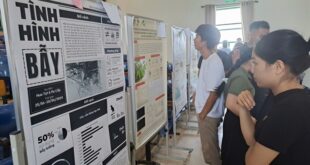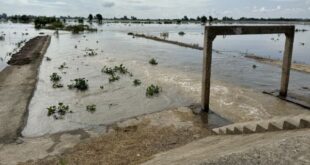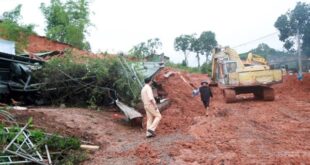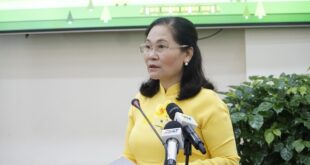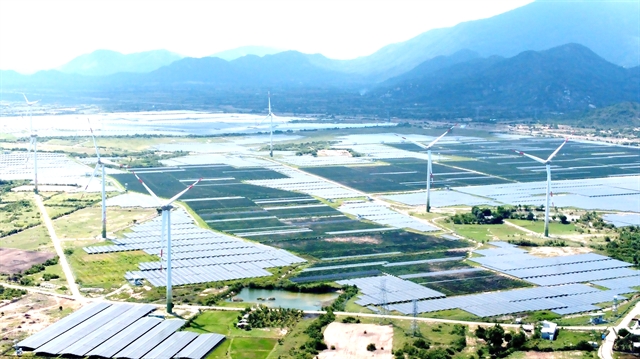 |
| The solar-wind power farm complex in Thuận Nam District, Ninh Thuận Province. — VNA/VNS Photo |
Việt Nam’s journey towards energy transition involves navigating a multitude of challenges, particularly in achieving the dual objectives of sustaining economic growth while reducing carbon emissions.
The country boasts substantial potential and advantages in harnessing renewable energy sources, especially solar and wind energy.
Việt Nam is progressing its energy transition by decreasing its dependence on fossil fuel-based electricity and prioritising the development of clean, sustainable energy sources to mitigate greenhouse gas emissions.
Natural favourability
According to the Ministry of Science and Technology, Việt Nam features several regions with high solar radiation, particularly in the central and southern provinces.
Recent years have seen the implementation of numerous solar energy projects.
The average annual solar radiation in Việt Nam is approximately 4-5kWh per square metre per day, creating good conditions for large-scale solar energy projects.
The coastal regions of central and southern Việt Nam possess significant wind potential, with a total wind energy capacity estimated at 513,360MW, including 42,000MW onshore and 471,360MW offshore.
Hydropower continues to be the primary energy source in Việt Nam, contributing about 30-40 per cent of the national electricity output.
The potential for new large hydropower projects has been largely exhausted but there is still scope for developing small and medium hydropower projects, especially in mountainous areas.
Regarding biomass energy, Việt Nam has abundant biomass resources from agricultural activities and wood processing. Several biomass energy projects have been implemented, primarily in the Mekong Delta region.
With high yields of rice and other crops, biomass from straw, sugarcane bagasse and other agricultural by-products can provide a significant energy source.
In terms of geothermal energy, Việt Nam currently has no geothermal power generation projects, but the country has substantial potential to develop geothermal power plants.
Emerging forms of ocean energy, such as tidal and wave energy, are beginning to be explored in Việt Nam.
The country’s long coastline and numerous islands make the development of ocean energy sources highly advantageous.
Strategic shifts and goals
Nguyễn Văn Vy, deputy chairman of the Việt Nam Energy Association, said that energy restructuring would help alleviate environmental pressures on Việt Nam.
Notably, the Government has approved Power Plan VIII, which aims to successfully implement a just energy transition linked with modernising production, building a smart grid, and advanced power management system, aligned with the global trend of green transformation, emission reduction and scientific and technological development.
By 2050, the proportion of renewable energy is projected to reach 67.5-71.5 per cent of electricity production.
In promoting renewable energy development, Vy noted that Việt Nam has many favourable natural conditions for this trend.
Solar and wind power are now competitive with coal-fired power due to technological advancements and large-scale investment projects.
From negligible capacity before 2017, Việt Nam’s power system now boasts over 16,500MW of solar power capacity (half of which is rooftop solar) and over 4,500MW of wind power capacity, accounting for 30 per cent of the national power system’s total capacity.
Renewable energy sources are expected to continue seeing a significant decrease in cost over the coming decades, while fossil fuel-based power costs are likely to rise due to increasingly stringent environmental protection requirements.
Additionally, the myriad issues caused by fossil fuels, such as air pollution and widespread climate change, have led the Government, businesses, investors and the public to recognise the necessity of reducing greenhouse gas emissions in the economy.
The Government has set a goal to rapidly increase the share of renewable energy in the overall energy balance, aiming for renewable energy to account for over 90 per cent of primary energy consumption by 2050, up from 31 per cent in 2020.
Technological advancements are accelerating the replacement of fossil fuels with renewable energy.
Vương Quốc Thắng, member of the Science, Technology, and Environment Committee of the National Assembly, said that the transition from fossil fuels to renewable energy is happening swiftly, driven by sustainable development needs and environmental safety requirements.
The increased use of clean and renewable energy, coupled with energy restructuring, is a significant and inevitable trend worldwide, especially after COP26.
Việt Nam must swiftly, safely and efficiently harness its wind and solar energy resources.
Promoting renewable energy development requires addressing key issues related to the legal framework, infrastructure, funding, human resources, technology and environmental impact assessments.
Thắng emphasised the need for specific policies to encourage private investment in energy projects, particularly in the electricity transmission system.
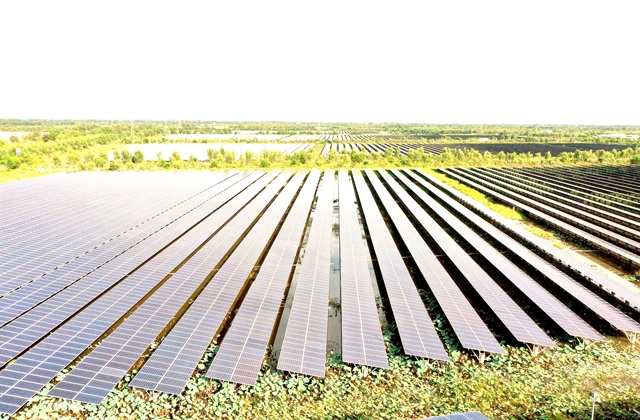 |
| Europlast Long An solar power plant in Mỹ Thạnh Bắc Commune, Đức Huệ District, Long An Province. |
Green economy
As one of the Asian nations that made strong commitments at COP26, Việt Nam’s net-zero emissions strategy targets a 43.5 per cent reduction in emissions by 2030.
This ambitious goal presents both challenges and opportunities, enabling Việt Nam to accelerate its economic restructuring towards sustainability, enhance competitiveness, and capitalise on new trade and investment opportunities.
The 2024 annual economic report of Việt Nam, “Energy Transition Towards a Green Economy,” by the Institute for Economic and Policy Research (VEPR), highlights that Việt Nam is nearing the maximum exploitation of its domestic fossil fuel resources and will need to import more coal and gas.
Việt Nam is becoming a net energy importer, with decreasing energy exports and increasing imports.
Coal remains the most used energy source (33 per cent of electricity production), followed by hydropower (29 per cent), renewable energy such as solar and wind (26 per cent), and gas-oil (9 per cent).
The report recommends enhancing domestic energy supply by investing in renewable energy sources to reduce dependence on fossil fuels and optimise Việt Nam’s natural potential.
Energy conservation is also advised to preserve national resources, protect the environment, and reduce greenhouse gas emissions, mitigating climate change impacts.
To promote renewable energy projects, supportive policies and financial mechanisms are needed to attract private and international investment.
Việt Nam should diversify its energy sources to meet domestic demand, aiming to increase the proportion of renewable energy in primary energy to 11 per cent by 2050. This requires developing modern infrastructure, applying advanced technologies for energy efficiency, and implementing supportive policies for a stable and sustainable energy supply.
The Government should provide incentives and financial mechanisms to encourage businesses and individuals in environmental protection, offer preferential loans and tax reductions for clean energy projects, and promote investment in energy-saving technology.
The “Việt Nam Energy Outlook Report,” jointly conducted by the Danish Government and the Ministry of Industry and Trade and released in June, emphasises accelerating the green energy transition to avoid unnecessary large costs.
It provides recommendations for Việt Nam to achieve climate neutrality by 2050 and peak carbon emissions by 2030.
To achieve net-zero emissions by 2050, Việt Nam should increase investment in renewable energy before 2030, primarily meeting additional electricity demand with renewable sources starting from 2025.
Ambitious short-term targets for renewable energy development should be set, minimising risks and delays in project approvals.
Opportunities and challenges
Nguyễn Sĩ Đăng, deputy director of the Department of Technology Appraisal, Evaluation, and Assessment at the Ministry of Science and Technology, highlighted the benefits and challenges of the energy transition.
Transitioning to renewable energy conserves resources, reduces environmental impacts by cutting CO2 and other greenhouse gas emissions and offers long-term economic benefits for businesses.
In Việt Nam, it also reduces dependency on imported energy.
However, the energy transition poses significant challenges. Large-scale deployment requires substantial initial investment, particularly for wind power.
The current grid infrastructure is inadequate for integrating renewable energy, necessitating upgrades to accommodate intermittent sources like solar and wind. Effective energy storage technologies are also needed to address intermittency.
Additionally, improving the legal framework, implementing supportive policies, and encouraging the development of renewable energy sources while phasing out fossil fuels is crucial.
Đăng said that Việt Nam’s science and technology policies should focus on promoting renewable and sustainable energy through national key technology programmes, fostering research and development, and facilitating the transfer of advanced technologies from developed countries.
Financial and tax support mechanisms, technical and financial assistance for renewable energy projects, and favourable conditions to attract businesses and organisations to engage in renewable energy research and development are essential.
He proposed increased government investment in renewable energy R&D, funding research institutes, universities, and enterprises, establishing research support funds, and providing tax incentives. Subsidies, financial support packages, and interest rate support for clean energy projects, as well as training programmes for a skilled workforce in renewable energy, should be implemented. Strengthening international cooperation in renewable energy research and technology transfer is also crucial.
Nguyễn Mai Dương, director general of the Department of Technology Development and Innovation at the Ministry of Science and Technology, said that successful energy transition relies on a competitive economy, market openness, supportive policies and technology.
The ministry approved the national-level science and technology programme to apply advanced technologies for clean and renewable energy.
It aims to enhance the quality, safety, and efficiency of energy production, transmission, and use, and includes developing nuclear reactor technologies and radiation and isotope technologies.
To meet Việt Nam’s net-zero emissions goal, the ministry also developed the NET Zero programme for 2023-2030, supporting the national commitment to limit global temperature rise. — VNS
- Reduce Hair Loss with PURA D’OR Gold Label Shampoo
- Castor Oil Has Made a “Huge” Difference With Hair and Brow Growth
- Excessive hair loss in men: Signs of illness that cannot be subjective
- Dịch Vụ SEO Website ở Los Angeles, CA: đưa trang web doanh nghiệp bạn lên top Google
- Nails Salon Sierra Madre
 VnExpress News The News Gateway of Vietnam
VnExpress News The News Gateway of Vietnam
